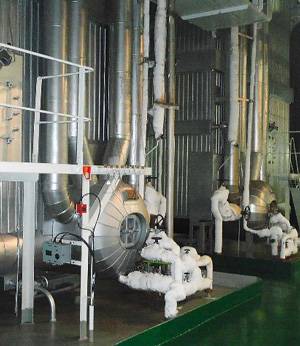Eliminating a hidden cost trap  (Photo: Milen Mkv – Shutterstock.com) |
|
Auxiliary boilers are typically not a top item on the maintenance agenda; equipment with moving parts is always a greater concern. Crews often find it difficult to decide what should take priority, so boiler deficiencies or downright failures often come as a surprise. What is more, the effects of the boiler condition on fuel efficiency are widely underestimated. The purpose of the BMON class notation is therefore to provide guidance to crews in maintaining auxiliary boilers efficiently, and to help owners and ship managers reduce deficiencies, repair and maintenance costs, and the associated downtime. As the track record shows, this mission has been fully accomplished: on ships with the BMON notation, unexpected and costly boiler trouble is a thing of the past.
The core problem: Water quality
 Active corrosion on water side steel surface without a passive magnetite layer (note the reddish shade). (Photo: DNV GL). |
|
Deposits and corrosion on the water/steam side of auxiliary boilers mainly cause the defects, as DNV GL surveyors have found in decades of inspections. The root causes of pressure part failure, apart from occasional workmanship issues during fabrication, typically include local pitting corrosion, overheating due to deposits, oil scale, flame impingement, insufficient water levels, soot combustion of fin/pin type water tube exhaust gas boilers, and cold corrosion from the gas side. The majority of these symptoms can be traced back to poor water condition and insufficient maintenance.
“The lack of a stable, passive magnetite layer on the metal surfaces on the water/steam side inside boilers appears to be the predominant contributory mechanism behind many of the reported defects,” explains Farahany. Regular monitoring of boiler water pretreatment is equally important to minimize the risk of corrosion.
Focus on maintenance
Several key requirements under the BMON class notation directly address the root causes of boiler corrosion. A passive magnetite protection layer must be formed on all steel surfaces and maintained properly, and the frequency o PHOTO:Igor Kardasov – Shutterstock.com |
|
f water condition checks is increased compared to customary procedures. These two measures alone should minimize the risk of corrosion on the steam and water-side surfaces. The enhanced focus on water treatment also prevents the formation of scale and other deposits, ensuring proper heat transfer at all times. This in turn improves fuel efficiency and avoids heat stresses or overheating and cracking of the furnace wall, the top plate and the screening tubes.
It is a known fact that conventional noon reports frequently fail to expose technical issues in a timely manner. The BMON rules therefore sharpen the focus on regular internal inspections to detect potential risks, such as flame impingement from a burner, before they result in a defect. Additional design optimization measures are required on the feed water system to avoid water-side contamination and excessive dissolved oxygen. These include the installation of salinometers, an oil content sensor and a hotwell temperature transducer, as well as the monitoring of the differential pressure across the exhaust gas boiler.
As an added benefit, the BMON class notation comes with a more flexible class survey scheme. As a result of the stricter boiler condition management and monitoring regime, the chief engineer’s inspection report prepared with the vessel in transit will be accepted by class as sufficient evidence provided it confirms satisfactory internal boiler condition. Part of the scope of every boiler survey which is not connected to the main class renewal survey can then be credited. This is documented for review and final acceptance by the DNV GL surveyor. This survey arrangement increases flexibility regarding the time and place of internal inspections. The remaining scope of the survey must still be carried out by a DNV GL surveyor; upon satisfactory review and completion of both parts, the survey is then formally credited.
Solid savings
 APassive and stable magnetite layer on water/steam side (reflected by a greyish black surface). (Photo: DNV GL) |
|
From conversations with operators which acquired the BMON class notation after having operated their ships without the notation for at least one five-year survey period, DNV GL frequently encountered the following typical scenario: “By being able to perform the water-side boiler inspection during a journey, we saved two days compared to an in-port survey. This resulted in savings equivalent to 48 hours of reduced off-hire time, as well as 48 hours of saved port and anchorage dues. This does not include any potential savings by avoiding boiler failure or as a result of being able to schedule repairs based on the chief engineer’s report,” says Ivo C.M. Legein, Senior Vessel Manager at Kristian Gerhard Jebsen Skipsrederi.
“With the BMON class notation DNV GL offers an alternative, efficient and flexible survey approach,” says Farahany. “Thanks to this notation shipowners and managers can reduce off-hire time while ensuring optimum boiler maintenance and performance.”
|
|










